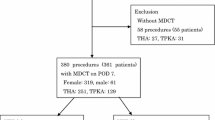Abstract
Introduction
Marked activation of thrombosis is common in patients undergoing total hip arthroplasty, especially during reaming of the femur and after insertion of the femoral prosthesis. This suggests that management designed to minimize deep vein thrombosis and fatal pulmonary embolism after total hip arthroplasty should be focused on the period during insertion of the femoral component. In some previous studies, a low dose of heparin administered intraoperatively was shown to suppress the formation of fibrin.
Objective
The present study was performed to evaluate the influence of intraoperative heparin administration on the D-dimer level and on the prevention of pulmonary embolism after total hip arthroplasty.
Material/methods
A total of 22 and 26 consecutive patients respectively underwent total hip arthroplasty with and without intraoperative administration of unfractionated heparin. Postoperatively, all patients wore knee-high elastic stockings and were fitted with calf-to-thigh intermittent pneumatic compression devices. Active ankle flexion and extension exercises were commenced as soon as motor function recovered. None of the 48 patients received prophylactic anticoagulants postoperatively.
Results
There was a significant difference of the mean D-dimer level on the 1st day between the patients with and without intraoperative administration of heparin (8.9 ± 6.6 vs. 15.7 ± 12.7, P < 0.05). Although there were no patients with symptomatic deep venous thrombosis and pulmonary embolism, asymptomatic pulmonary embolism was detected by pulmonary perfusion scintigraphy in three patients who did not receive intraoperative heparin. The operative blood loss and postoperative drainage were similar in both groups and no bleeding complications were observed. In conclusion, we recommend a safe and inexpensive regimen comprising 1,000 U of intravenous unfractionated heparin intraoperatively, postoperative pneumatic compression, and early active mobilization for prevention of thoromboembolic complications after total hip arthroplasty.

Similar content being viewed by others
Reference
DiGiovanni CW, Restrepo A, Valle AGD, Sharrock NE, McCabe JP, Sculco TP, Pellicci PM, Salvati EA (2000) The safety and efficacy of intraoperative heparin in total hip arthroplasty. Clin Orthop 379:178–185
Mant MJ, Russell DB, Johnston DWC, Donahue PA (2000) Intraoperative heparin in addition to postoperative low-molecular-weight heparin for thromboprophylaxis in total knee replacement. J Bone Joint Surg 82–B:48–49
Nassif JM, Ritter MA, Meding JB, Keating EM, Faris PM (2000) The effect of intraoperative intravenous fixed-dose heparin during total joint arthroplasty on the incidence of fatal pulmonary emboli. J Arthroplasty 15:16–21
Planes A, Vochelle N, Fagola M (1990) Total hip replacement and deep vein thrombosis. A venographic and necropsy study. J Bone Joint Surg Br 72:9–13
Reitman RD, Emerson RH, Higgins LL, Tarbox TR (2003) A multimodality regimen for deep venous thrombosis in total knee arthroplasty. J Arthroplasty 18:161–168
Sharrock NE, Go G, Harpel PC, Ranawat CS, Sculco TP, Salvati EA (1995) Thrombogenesis during total hip replacement. Clin Orthop 319:16–27
Sharrock NE, Go G, Sculco TP, Salvati EA Westrich GH, Harpel PC (1999) Dose response of intravenousheparin on markers of thrombosis during primary total hip replacement. Anesthesiology 90:981–987
Warwick D, Williams WH, Bannister GC. (1995) Death and thromboembolism after total hip replacement. J Bone Joint Surg Br 77:6–10
Westrich GH, Salvati EA, Sharrock N, Potter HG, Sanchez PM, Sculco TP. (2005) The effect of intraoperative heparin administered during total hip arthroplasty on the incidence of proximal deep vein thrombosis assessed by magnetic resonance venography. J Arthroplasty 20:42–50
Reitman RD, Emerson RH, Higgins LL, Tarbox TR (2003) A multimodality regimen for deep venous thrombosis in total knee arthroplasty. J Arthroplasty 18:161–168
Author information
Authors and Affiliations
Corresponding author
Rights and permissions
About this article
Cite this article
Maezawa, K., Nozawa, M., Aritomi, K. et al. Changes of D-dimer after total hip arthroplasty in patients with and without intraoperative heparin. Arch Orthop Trauma Surg 128, 37–40 (2008). https://doi.org/10.1007/s00402-007-0361-4
Received:
Published:
Issue Date:
DOI: https://doi.org/10.1007/s00402-007-0361-4




